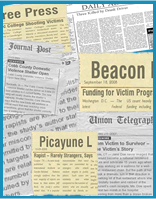
PAGE INDEX
a. Outreach to Reporters
b. Getting to Know Reporters
c. Seeking Pro Bono Support
d. Tips On Approaching the Media
e. Tips for the Good Pitch
f. Turning Data into News
i. Preparation
g. Tools of the Trade
h. Document Your Successes
How to Build Strong Media Relations in Your Community
a. OUTREACH TO REPORTERS: Outreach to Police Reporters and Court Reporters
Victim service providers who work for nonprofit organizations often want publicity and positive media attention for their efforts. A difficult part of that relationship is fielding victims who can speak to reporters about what happened to them, since the risks can outweigh the benefits for some victims. Another thing that advocates and service providers can do is provide leads on good stories and “package” what they do in ways that appeal to reporters. When you want media attention for your activities and events—
- Think like a reporter. Reporters tell stories. Some of those stories address issues but in the context of talking about how those issues affect the lives of real people. Cast your outreach in terms of human stories.

- Turn what you do into a report. How many victims did you work with this year compared to last year? What new issues or trends have emerged? How is the community doing overall in responding to various kinds of victimization? Issuing an annual report or a “community scorecard” can take what your organization is already doing and turn it into “news” (see “Turning Data into News”).

- Find a fresh angle for annual events. Many organizations have one or two big events a year that raise awareness and sometimes also raise funds. The challenge is to make the event newsworthy each year. Find a spokesperson with a fresh story to tell. Use the data you gather to explain why this year is different. Remember to stress the new elements when talking with reporters and editors.
Create and Sustain Relationships:
Getting to Know News Directors, Editors, and Reporters
There are many professionals who constitute “the news media” and represent print, broadcast, and Web-based media (see “Types of News Media”). Strong media relations are reciprocal in nature: While the news media help meet the needs of victim assistance organizations related to victim outreach and public awareness, it is essential to examine what your organization can offer to the media. Effective media relations are both proactive (seeking opportunities for media coverage) and reactive (responding to current news) in nature.

Truth and trust go hand-in-hand in good media relations. When the media begin to view your organization as a reliable source, their trust in you will cement a good foundation for an ongoing relationship.
Good media relations don’t happen by accident—they require proactive planning and action. This means identifying key journalists in your community, and reaching out to them with reliable information and resources they can use.
Personal contacts are essential. Victim advocates can introduce themselves to the media—in person or by telephone or written contacts—as a good local source for information and referrals. You can also enhance media relations by responding to past media coverage: a letter to a reporter or his or her supervisor or, even better, a letter-to-the-editor that compliments a good story or sensitive coverage of a victim’s case helps create positive media relations.
It is important to establish your organization as a reliable source with timely information about crime and victimization:
- By staying on top of national, state, and local trends and issues related to crime and victimization, you can alert the media to important news and provide local angles that depict its effect on your community.
 An organization’s general victim and public information is critical to success. Your web site, brochures, newsletters, electronic listservs, and other outreach venues should clearly establish your mission, values, goals, programs, and services that depict your purpose to the media, and are updated to reflect trends in your organization or the field of victim services.
An organization’s general victim and public information is critical to success. Your web site, brochures, newsletters, electronic listservs, and other outreach venues should clearly establish your mission, values, goals, programs, and services that depict your purpose to the media, and are updated to reflect trends in your organization or the field of victim services.- The media are always looking for reliable experts and spokespersons. You can develop and continually update a diverse roster of potential interviewees, including crime victims and survivors.
- “Around-the-clock” availability can set your organization apart. Be available to the media at all times and develop a plan that ensures your availability 24-hours-a-day for breaking news, including contacts via work and cell phones and e-mail addresses.
- Cultural competence is essential. Your access to information about and referrals to spokespersons who represent diverse perspectives can establish you as a valuable source for journalists (see “Cultural Competence in Media Relations” ).

In addition, “National, State, and Local Trends and Data Related to Crime,
Victimization and Victim Assistance” in Section 1 of this guide offers suggestions about the most important information that victim advocates can provide to the news media.
c. SEEKING PRO BONO SUPPORT: Seeking Pro Bono Support for Public Awareness Activities
The range of media relations experience among victim advocates varies significantly. It’s helpful to consider sources within the community that can provide pro bono (i.e., free) support for an organization’s public awareness efforts, which can contribute to—
- Development of an overall media plan and strategy.
- Writing materials that describe an organization’s programs, services, and value to a community.
 Graphic design support for creating public awareness advertisements, posters, and billboards.
Graphic design support for creating public awareness advertisements, posters, and billboards.- Web site development and maintenance.
- Providing training for staff on effective media relations.
Who can provide pro bono support for media relations and public awareness?
- Crime victims/survivors served by an organization who have media relations expertise and want to volunteer.
- Public relations and advertising firms (especially newer and small firms that are looking to make a name for themselves).
- Colleges and universities—including students from communications, journalism, public relations, and graphic arts programs—that can provide volunteers for specific projects or interns for entire semesters.
- Commercial art schools whose students can contribute to creative graphic design for public awareness activities.
- For nonprofit organizations, efforts can be made to seek board members who are writers, journalists, or public relations experts.

In identifying pro bono sources, it is important to remember that public recognition of their contributions is essential. Pro bono contributors can be thanked through letters-to-the-editor, public recognition during annual commemorative observances, and awards that honor volunteer support of an organization.
Detroit Free Press columnist Desiree Cooper offers these suggestions for how to approach the media:25 25. Desiree Cooper, “10 Practical Tips on Approaching the News Media,” Detroit Free Press, 2001.
- Know the difference between a news story, a column, and an ad.
- Don’t call reporters on their deadlines. After 3 p.m. is the worst time for most reporters who work on morning papers or for evening news broadcasts.
- Start with a reporter and work your way up, unless you already have a good relationship with an editor.
- Speak in sound bites, not speeches.

- Use e-mail and voicemail—don’t insist on personal interactions at first.
- Humor is your friend.
- Be prepared to follow up conversations with more information: fact sheets, names and phone numbers, Web sites, and faxes.
- If you are rejected because your pitch is not in the reporter’s beat, ask if there is someone else at the media establishment who may be interested.
- Make as many calls as you can yourself. Public relations professionals rarely have the same depth of knowledge or interest in the topic as an advocate.
- Be upbeat and enthusiastic. If you’re not interested, why should anyone else be interested?
 Click here for printable pdf of list above.
Click here for printable pdf of list above.
How do you make your public awareness activities “stand out in a crowd”? Desiree Cooper offers 10 great tips that can make your media outreach stand out: 26 26. Desiree Cooper, “10 Ways to Make a Good Pitch.” Detroit Free Press, 2001.
- Tell me about people, not events. Try not to pitch another rally or banquet. Find a story involving real people or a current issue (a bill being introduced, a government policy change, a grassroots movement) and pitch that, not the event.
- Give me enough lead time. Because we write several columns a week, columnists are often looking ahead, scheduling issues they want to cover based on the seasons (holiday stress, summer reading, winter sports), social cycles (school year, legislative sessions, sports seasons, wedding season, etc.), and landmarks (anniversaries of wars, historical moments, births, and deaths). In between, there’s breaking news or pop events that make for great commentary. You have to wedge your idea between the many items on my agenda. Don’t wait until the last minute. Two to 3 weeks’ lead is the optimal time to make a pitch. Some organizations have sent me mail for an entire year before someone calls to pitch a specific story.
- Don’t try to convert me. I’m an old dog who can learn new tricks, but I’m not likely to learn them by getting beat up by a publicist. If I am a liberal, I’m probably never going to write a pro-gun column, no matter how long your e-mails are or how impassioned your phone calls. It is much better to find a columnist who you think—based on past columns—would be open to your point of view. As an aside, there’s a difference between converting and educating a writer. I may have only cursory information about your topic. In that case, a fact sheet, a series of e-mails, or even a conversation over lunch can be very helpful to a columnist.
- Along the same lines, pitch to the right person. Don’t pitch sports to a travel writer. Don’t pitch food to a fashion writer. Do your research and be able to articulate why you’ve chosen me for your story.
- Pitch it and let it go. Don’t pitch the story and then try to write it. The journalist has some say on whether to take the pitch, but many other hands often get into the brew. Editors decide the relative importance and priority of the story. Photographers may or may not cover the event. Headline writers are a separate department and may not characterize the story as you planned. You have to make your pitch, provide as much information as possible, and move on. The story may not land when you need it. It may not credit every Tom, Dick, and Harry in your organizational food chain. It may not depict the person you chose to be your spokesperson. Yet, it still may do the heavy lifting of creating sympathy/interest/understanding about your issue.
- Don’t kill the messenger. I once did a story about a UFO advocate. It’s rare for journalists to take a person seriously who claims to have seen/visited UFO’s. When I did, there was hell to pay. Not from the skeptics who didn’t believe in UFO’s, but from the believers who wrote and called me to complain that journalists never take them seriously—even though I had. It’s not the best way to make friends and influence people. If you advocate a topic that is often marginalized by the media, it’s best to try to cultivate interest in the topic than to berate the few writers who have shown interest. If, however, I have committed a serious error of fact, or given the wrong impression, please let me know so that a correction can be run.
- Prevail upon our relationship sparingly.
If I wrote about you last month, I’m not likely to write about you this month. If I covered your annual awards ceremony, don’t count on me covering it this year. I once asked a caller whether she was looking for coverage before or after her event. “Well, both would be great,” she said.
Not likely. Unless it’s something like the presidential elections, you’re not likely to get pre- and post-coverage of the same event. Know what would serve your organization best and target your publicity to achieve that outcome.
- Drop names whenever possible. Because I’m often choosing between many equally important ideas, it helps me to know if I have a connection with the subject or the people involved. Sometimes that can backfire (especially for a reporter who has to worry more about conflicts of interest), but more often it helps me warm up to the idea, inching it closer to good material for a column.
- Don’t give me a pitch you’ve given to five other columnists/reporters. I don’t need an exclusive, but I also don’t need to spend time on a gripping, one-of-a-kind story that will show up in another news outlet before my deadline. Think of many angles to one story and pitch each media outlet a different one, or pitch many angles to one writer, let her choose, then pitch the remaining ideas to other writers.
- Mind your manners. Remember that, in some ways, this is a beauty contest. The most gripping ideas that can be produced with the least amount of grief will move to the top of the heap. Subconsciously, I have put off many good stories because the source was rude and demeaning. Sometimes, I have stayed with the idea, but tried to find another source for the story. That may not serve your organization’s needs very well, so just remember to be as helpful, enthusiastic, and engaging as possible.
At the national, state, and local levels, there are many research-based data about crime and victimization. These include research and case studies, statistics, scientific journal articles, and the results of program evaluations. Many data are newsworthy, but are often presented in a manner that is too broad, too complicated, or that lacks relevance to a local community.
The media often receive data in press releases or other sources that are presented from a national perspective. Here are some guidelines to “make data matter” to the news media:
- Provide the media with a local angle that makes statistics relevant to a community. National trends should be compared with state or local trends for maximum impact.
- Partner with local academia to conduct local studies, surveys, and program evaluations that address victimization issues specific to a jurisdiction. Academicians can also help you and the media quickly interpret research findings, and can review research methodology to point out strengths or any flaws that may affect its outcomes.
- Maintain a roster of spokespersons and experts—such as justice professionals, criminologists, and psychologists—who can address the findings of newsworthy data related to crime and victimization. This requires a good communications network, and the ability of spokespersons to respond rapidly to cutting-edge news.
- Crime victims and survivors offer a unique, personal perspective of crime-related data. If they are provided with a summary of research findings, they can respond and humanize the data from their own viewpoint and experiences.
- There may be local initiatives (such as research, surveys, and case studies) that support or negate the key findings of crime-related research.
- National data can be used to create “report cards” for a jurisdiction that offer comparisons to national trends and focus on what is happening at the community level. The simple use of “As, Bs, and Cs” can offer a simple, subjective comparison to what’s happening nationally.

In addition, “National, State, and Local Trends and Data Related to Crime,
Victimization and Victim Assistance” in Section 1 of this guide offers suggestions about the most important information that victim advocates can provide to the news media.
i. RESOURCES FOR CURRENT DATA: Resources for Current Data about Crime and Victimization
Efforts to turn data into news require proactive planning from victim advocates. It means staying on top of what is going on in the worlds of public safety, justice, victims’ rights, and services, and getting current information at the same time it’s disseminated to the media in order to formulate an effective local response or angle. Some resources for victim advocates:
- The World Wide Web offers a treasure trove of information about crime victims’ rights, services, and issues. Learning how to use “key words” for search engines will result in an instant library full of timely information.
- The U.S. Department of Justice, U.S. Department of Health and Human Services, and other federal agencies have Web sites that include current news, listservs, training and educational Web forums, electronic discussion groups, bulletin boards, and other venues to keep their constituents informed about cutting-edge issues (please see http://ovc.ncjrs.gov/ncvrw2011/pdf/stat-overviews.pdf).
- Major national victim assistance and criminal justice organizations offer myriad resources for victim and public awareness (see “Resources”). Victim advocates can sign up for listservs and e-groups that regularly disseminate information about crime and victimization. A quick glance at electronic information will cull resources that are useful.
- Advocates can join state and local coalitions that address crime victim issues. They provide timely information about issues and events on a regular basis.
- While subscribing to journals is a budgetary consideration, they often offer new, research-based data about trends in crime and victimization.
There are numerous “Tools of the Trade” that can help victim advocates develop stronger media relations:
- Document Your Successes

- Guidelines for Media Interviews
- Press Releases
- Editors’ Advisories
- Public Service Announcements
- Letters-to-the-Editor
- How to Conduct a Press Conference
- Preparing an Editorial Board Presentation
- Creating an Internet Strategy
Among the most effective tools for media and public relations are the positive things that other people have to say about your organization. While people are usually pleased and flattered to receive accolades for their good work and stellar efforts, they seldom consider how such statements can be useful for media relations and public outreach.
Statements of recognition for an organization can come from a variety of venues, such as—
- Crime victims who write letters and e-mails of thanks to an organization or a particular staff member for helping them and making a real difference in their lives.
- Complimentary letters or proclamations from legislators or state executive branch offices.
- Awards that are given to a victim assistance organization, and the often effusive commentary that accompanies their presentation.

- Statements from allied professionals that highlight an organization’s role as a key partner in fighting crime and assisting victims.
- Media reports—both in broadcast and print formats—that offer positive comments about an organization’s programs and services.
Victim assistance organizations should develop a plan to document “what others are saying about” their organization. Quotations and sound bites from crime victims, public and civic leaders, and the media can always augment victim outreach and public awareness strategies, and offer unique perspectives about how an organization makes a critical difference in a community or state. Of course, permission should be received to directly quote sources and, in cases where people do not want to be identified by name, determine attribution that does not infringe on their privacy.




